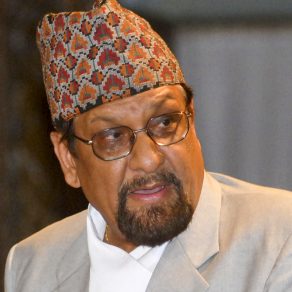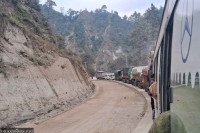Opinion
Constitutional rumblings
Allegations about the constitution being elitist and non-inclusive are distressingly jarring
Ram Sharan Mahat
The promulgation of the new constitution in Nepal has led to a contested response of an unforseen intensity. Although overwhelmingly approved by the Constituent Assembly (CA), and celebrated by a vast majority of the public, it has met a violent resistance in parts of the Tarai-Madhes. While the global community at large received the news warmly, the reaction of our immediate neighbour, India, whose support would have mattered the most, was frigid. The Madhes agitation continues to this day, bolstered for the past eight weeks by a defacto trade and transit blockade from the Indian side. Because India accounts for two-thirds of Nepal’s trade, and 90 percent of third country trade requires Indian passage, the economy today is virtually strangulated, with millions of Nepali people suffering from lack of access to even essential fuel, food and medicines. Several UN agencies have already warned of a looming humanitarian crisis because the blockade aggravates the urgent rehabilitation and reconstruction needs in the aftermath of the devastating earthquake. While negotiations are underway to resolve the crisis,
no one should lose sight of the landmark constitutional achievements.
Task intractable
The principal political parties of Nepal faced mammoth challenges in charting a democratic way forward. They attempted to draft a broadly acceptable constitution involving an eclectic mix of 601 elected and nominated members of the CA from parties that were diametrically opposite ideologically and distrustful of each other against the backdrop of a crippling, decade-long insurgency. It was under the weight of this complexity that the first elected CA (2008-2012) failed to deliver. All of Nepal’s prior constitutions had been written by an elite group of experts and jurists, and ‘gifted’ to the people by an absolute monarch. In the second CA elected in 2013, the parties struggled with the intractable task of finding a compromise among radical Maoists, monarchists and regional parties in the Madhes and elsewhere who championed an ethnic cause.
Another challenge for the new constitution was to institutionalise a new republic and adopt a federal structure, which it has successfully done. These are significant milestones for a country which was a monarchy throughout history. Federalism was an alien notion to the Nepali public, and opinion polls show that the majority remain ignorant or suspicious of what this implies. Indeed, federalism was a specific demand which the other parties accepted to placate the Madhesis, and to wean the country away from the so-called ‘autonomous ethnic provinces’ initially advocated by the Maoists. Furthermore, unlike federalism by ‘aggregation’ where independent nation states voluntarily come together for security, economic and other considerations, ‘disaggregating’ a unitary nation forged over 250 years was not a smooth affair.
Some foreign media in particular has done a great disservice by distorting and misrepresenting the new constitution and by under-estimating the throes of compromise inherent in an historical exercise that molds Nepal into an inclusive and socially progressive republic. Allegations and false propoganda about the constitution being elitist and non-inclusive favouring Hill Khas supremacy are distressingly jarring.
Inclusive and progressive
The progressive guarantees of Nepal’s constitution are probably without parallel. One third of the parliamentary seats are reserved for women at both the federal and provincial levels; 40 percent of parliamentary seats are to be filled in a proportional manner to redress the likely under-representation of women, Dalits, Madhesis, indigenous communities, and lagging regions. Responding to the elevated aspirations of our diverse peoples, the constitution provides for an elaborate set of social, political,economic and cultural rights. A list of 31 fundamental rights includes, inter alia, rights to employment, food, housing, social security, and education in the native language. Special rights are guaranteed for children, elderly, disabled, visually impaired, and sexual minorities. Constitutional bodies have been formed to monitor, further define and facilitate the implementation of constitutional rights and provisions separately for women, Dalits, indigenous peoples, Madhesis, Tharus, Muslims and other minorities.
These features, together with other democratic political rights aim at building a just and inclusive sociey. The real challenge in the coming days will be to enforce and implement the numerous constitutional rights and provisions, given the country’s level of development and capacity to deliver.
Population-based representation
Another allegation that the constitution has not accepted population-based parliamentary representation is also untrue. The constitution clearly foresees representation based on population, and also geography, taking into account Nepal’s specific character of demographic distribution. The hugely inaccessible Himalayan districts with low population densities, like Karnali, coexist with the densely-populated districts of the Kathmandu Valley and the Tarai. If population remains the sole basis for representation, about 18 Himalayan districts will not have proper representation. The population density in some of these districts is as low as 3 to 10 persons per square kilometer that it takes months on foot to visit all settlements of a single constituency as compared to around 500 per square kilometer in central and eastern Tarai.
Each Nepali district carries a distinct cultural and historical identity which if shortchanged in parliamentary representation would be unfair and against the principle of inclusion. It is a common practice in all democracies, from India to the US, to consider other aspects too while retaining population as the primary criterion. If population had been the sole factor in India, the Lok Sabha would have much larger representation from the populous northern states, and none of the smaller states and union territories like Sikkim, Pondicherry, Andaman and Nicobar Islands, Lakshadweep, Mizoram and Nagaland would have a single seat. In Nepal, despite difficult geography, hill districts would be prepared to accept population-based representation at par with the Madhes. But the high Himalayan districts unable to reach the threshold required for even one seat on a first-past-the-post basis would need a special treatment. Under this arrangement, the Madhes is estimated to garner 48 percent of the seats in the national legislature which is the same as now. The assertion by some commentators that the Madhes will get just one-third of the seats is thus a lie. In fact, the loser in this process will be the mid-hill districts whose average constituency population will be higher than that of the Madhes. Nineteen hill districts will be reduced from two seat districts to one seat despite having a population larger than required for one seat, but short for two seats.
Provincial division
No doubt, the delineation of federal provinces has been the most contentious issue. There are calls for two exclusive Madhes provinces, or a merger of Morang and Sunsari districts in the proposed Province 2, and Kailali in Province 5, while separating the hill districts. None of this is without problem and opposition. Rather than leaving the fate of such districts to behind-the-scene machinations of a few politicians, people on the ground who are the ultimate stakeholders must have their say. As it concerns their future they have the sovereign democratic right to decide which particular province, A or B, they wish to align with.
A rational approach requires pragmatism rather than emotion to guide the formation of provinces, considering factors like economic interdependence and viability, geography, ethnic composition and administrative convenience. Given the diversity of positions and emotional underpinnings, it is practically impossible to accept any particular group’s position in its entirety. Compromise, as was used to settle tens of other contentious issues, is the only way forward. Given the complementarity of resource endowments in the hills and the Madhes, a generally mixed model would be preferable. But this will be a difficult pursuit when positions harden and animosities increase.
Mahat is former Finance Minister and Nepali Congress leader




 6.3200000000001°C Kathmandu
6.3200000000001°C Kathmandu












